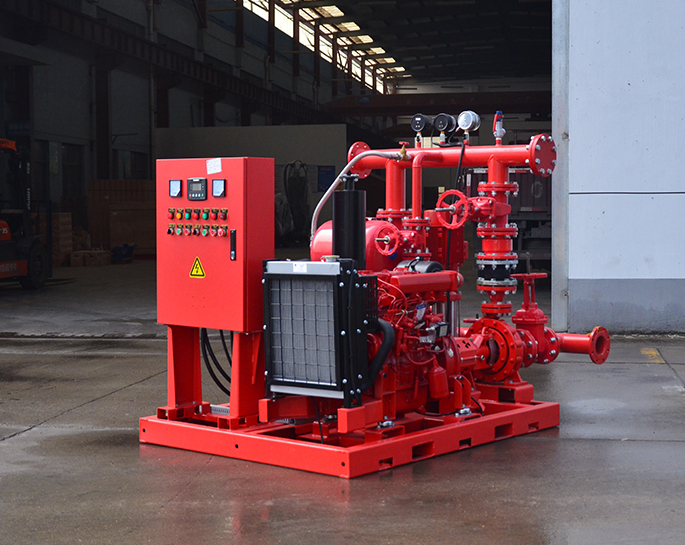How are fire pumps tested for reliability and performance during their lifespan?
Feb 02, 2024
Share:
Fire pumps are critical components in firefighting systems, and their reliability and performance must be regularly tested to ensure they function as intended during emergencies. The testing procedures typically include:
1. **Weekly or Monthly Inspections:**
- Visual inspections to check for any signs of damage, leaks, or corrosion.
- Verify that the pump and motor are securely mounted.
- Ensure that the pump room is clean and free from obstructions.
2. **Flow Testing:**
- Regularly conduct flow tests to ensure that the pump can deliver the required water flow at the proper pressure.
- Flow testing involves opening test headers and measuring water flow using calibrated equipment.
3. **Net Positive Suction Head (NPSH) Testing:**
- Verify that the pump has an adequate NPSH, ensuring it can draw water effectively without cavitation.
4. **Pressure Testing:**
- Conduct pressure tests to ensure that the pump can generate and maintain the required discharge pressure.
- This may involve using pressure gauges, flow meters, and other instrumentation.
5. **Driver Testing:**
- For electric motor-driven pumps, test the motor regularly to ensure it is operating within its specified parameters.
- For diesel engine-driven pumps, run engine tests to verify proper functioning and performance.
6. **Diesel Engine Start-up Tests:**
- For diesel-driven fire pumps, regularly test the engine starting system to ensure it operates as intended.
7. **Alignment Checks:**
- Verify proper alignment between the pump and the driver (motor or engine) to prevent mechanical issues.
8. **Lubrication Checks:**
- Ensure that all lubrication points are adequately lubricated according to the manufacturer's recommendations.
9. **Annual Comprehensive Testing:**
- Conduct a comprehensive annual test that includes a full-load operational test, checking for any abnormal sounds, vibrations, or overheating.
- During this test, verify that all safety features and interlocks are working correctly.
10. **Record Keeping:**
- Maintain detailed records of all tests, inspections, and maintenance activities performed on the fire pump.
11. **Certification and Compliance:**
- Ensure that the fire pump and associated components comply with relevant standards and regulations. Regularly check and update certifications.
12. **Professional Inspection:**
- Periodically, have a qualified professional inspect the fire pump to identify any potential issues and ensure it meets current standards.
Regular testing and maintenance are crucial to the reliability and performance of fire pumps. Any deviations from expected performance should prompt immediate investigation and necessary corrective actions to ensure the system's effectiveness during an emergency. Always follow the manufacturer's guidelines and relevant industry standards for testing and maintenance procedures.

1. **Weekly or Monthly Inspections:**
- Visual inspections to check for any signs of damage, leaks, or corrosion.
- Verify that the pump and motor are securely mounted.
- Ensure that the pump room is clean and free from obstructions.
2. **Flow Testing:**
- Regularly conduct flow tests to ensure that the pump can deliver the required water flow at the proper pressure.
- Flow testing involves opening test headers and measuring water flow using calibrated equipment.
3. **Net Positive Suction Head (NPSH) Testing:**
- Verify that the pump has an adequate NPSH, ensuring it can draw water effectively without cavitation.
4. **Pressure Testing:**
- Conduct pressure tests to ensure that the pump can generate and maintain the required discharge pressure.
- This may involve using pressure gauges, flow meters, and other instrumentation.
5. **Driver Testing:**
- For electric motor-driven pumps, test the motor regularly to ensure it is operating within its specified parameters.
- For diesel engine-driven pumps, run engine tests to verify proper functioning and performance.
6. **Diesel Engine Start-up Tests:**
- For diesel-driven fire pumps, regularly test the engine starting system to ensure it operates as intended.
7. **Alignment Checks:**
- Verify proper alignment between the pump and the driver (motor or engine) to prevent mechanical issues.
8. **Lubrication Checks:**
- Ensure that all lubrication points are adequately lubricated according to the manufacturer's recommendations.
9. **Annual Comprehensive Testing:**
- Conduct a comprehensive annual test that includes a full-load operational test, checking for any abnormal sounds, vibrations, or overheating.
- During this test, verify that all safety features and interlocks are working correctly.
10. **Record Keeping:**
- Maintain detailed records of all tests, inspections, and maintenance activities performed on the fire pump.
11. **Certification and Compliance:**
- Ensure that the fire pump and associated components comply with relevant standards and regulations. Regularly check and update certifications.
12. **Professional Inspection:**
- Periodically, have a qualified professional inspect the fire pump to identify any potential issues and ensure it meets current standards.
Regular testing and maintenance are crucial to the reliability and performance of fire pumps. Any deviations from expected performance should prompt immediate investigation and necessary corrective actions to ensure the system's effectiveness during an emergency. Always follow the manufacturer's guidelines and relevant industry standards for testing and maintenance procedures.


.png)
.png)

.png)


